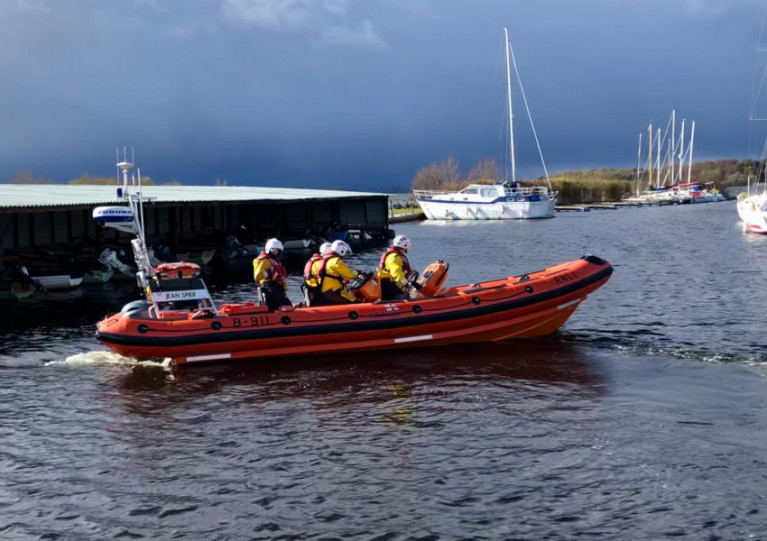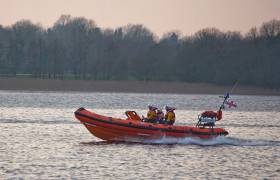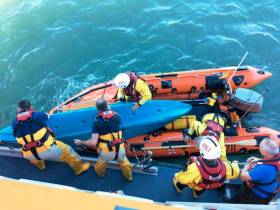Displaying items by tag: Saving Lives at Sea
Carrybridge RNLI Lifesavers Feature in BBC’s Saving Lives at Sea
Following their fellow Northern Ireland lifeboat volunteers in Larne, as reported last month on Afloat.ie, the crew at Carrybridge RNLI will feature in the latest series of Saving Lives at Sea on BBC Two at 8pm next Thursday 23 November.
Carrybridge RNLI helm Chris Cathcart, who was on both call-outs that will feature in the upcoming episode, said: “Our lifesaving work would not be possible without donations from the public and we are delighted to be able to share a frontline view of the rescues they support with their kind generosity.
“This is the first time Carrybridge RNLI features on the Saving Lives at Sea series and the rescues are a good example of where our volunteers’ training, skills and experience all come to the fore in helping bring casualties — and in the second case, animals — to safety.
“The RNLI can often carry out animal rescues which can be important in ensuring no one else puts themselves in danger in trying to rescue their own pet or animal in the water. The episode also highlights the great teamwork not just among our own volunteers but with our colleagues from the various emergency services.”
Cathcart added: “The first rescue comes late on a summer’s evening when the casualty has an accident with the digger he is working from and sustains a leg injury.
“He makes the correct decision to swiftly call for help and a multi-agency response and coordination from our own volunteers and our colleagues in the Irish Coast Guard’s Rescue 118 helicopter at Sligo swings into action and works exactly as we train for in such situations.
“The second call-out sees us come to the rescue of a distressed cow heavily stuck in mud and with most of its body submerged in water.
“The police, fire service and the farmer who owns the cow all play their part as she becomes tired and weak and shivers in the cold. After several attempts, the cow is eventually brought to safety and able to stand and feed on the grass.
“No one likes to see animals in any kind of danger and again the swift response by multiple agencies and the farmer himself, ensures a successful outcome”.
If you get inspired to volunteer with the RNLI by the TV series, there are a variety of roles from lifeboat crew, to fundraiser, lifeguard to shop volunteer. Fund out more at rnli.org/volunteer.
The volunteer lifeboat crew from Larne RNLI in Northern Ireland will feature in the new series of popular TV show Saving Lives at Sea on BBC Two at 8pm next Thursday 12 October.
Featuring footage captured on helmet and boat cameras, viewers watch dramatic rescues through the eyes of RNLI lifesavers while meeting the people behind the pagers and those rescued by the charity’s lifesavers.
The popular 10-part documentary is now in its eighth series and includes the lifesaving work of RNLI volunteer lifeboat crews and lifeguards from around Ireland and the UK.
It’s also available to watch on the BBC iPlayer for viewers in the UK following broadcast.
Including interviews with lifeboat crews and lifeguards, the series will also hear from those rescued and their families who, thanks to RNLI lifesavers, are here to tell the tale.
This forthcoming episode, on Thursday 12 October, includes Larne RNLI’s rescue of a capsized kayaker alongside rescue stories from their colleagues at other stations and beaches around the coast.
Larne RNLI helm Barry Kirkpatrick, who was on the call-out and will feature in the upcoming episode, said: “Our lifesaving work would not be possible without donations from the public and we are delighted to be able to share a frontline view of the rescues they support with their kind generosity.
“This is the first time Larne RNLI features on the Saving Lives at Sea series and this rescue is a good example of where our volunteers’ training, skills and experience all come to the fore in helping bring a casualty to safety. It also highlights the great teamwork not just among our own volunteers but with our colleagues from the various emergency services.
“The call for help in this rescue comes late at night following reports of a person capsized from their kayak. After a search, we locate the casualty floating on his back in the middle of the bay, who is estimated to be in the water for up to one hour and very cold.
“We bring him onboard the lifeboat and make our way back to the beach as quickly as possible while beginning first aid to try and warm him up but we are concerned about signs of hypothermia. Once on shore, we are assisted by our colleagues in the coastguard and the Northern Ireland Ambulance Service.
“In this rescue, the casualty's wife does the right thing by calling 999 and asking for the Coastguard when she realises her husband is in difficulty in the water. The kayaker also does the right thing by floating on his back with his arms stretched out. He is floating to live.”
If you get inspired to volunteer with the RNLI by the series, there are a variety of roles from lifeboat crew, to fundraiser, lifeguard to shop volunteer. Fund out more at rnli.org/volunteer
RNLI Save Two Pilots in Distress Off the Coast of Jersey
Footage from the RNLI shows the volunteer lifeboat crew battling through 2-3metre swells, rain and winds of up to 35mph before reaching the two men who had managed to escape the sinking plane and climb inside a liferaft, fitted with a personal locator beacon.
All three of Jersey RNLI’s lifeboats launched – from St Helier and St Catherine – in a major multi-agency operation on Thursday, 3 November, which also involved Jersey Coastguard, Channel Islands air search and a French rescue helicopter.
One of the pilots onboard, Paul Clifford, said: ‘If the RNLI hadn’t rescued us it would have been a different story. I don’t know of anyone else who’s been in that situation and survived.
‘I was undergoing some advanced refresher training when, at the furthest point from the runway, the engine lost power. We did all we could to get the engine going again, but had to ditch the plane. We knew it was incredibly risky and we were unlikely to survive.
‘We climbed onto the wing and had our lifejackets on, and liferaft prepared. We were stood on the wing for around three minutes before the plane went down.’
Locating the casualties was made simpler by the personal locator beacon they were carrying – a portable, battery-powered radio transmitter used in emergencies to locate people in distress at sea in need of immediate rescue.
James Hope, volunteer lifeboat helm at St Helier RNLI, said: ‘The casualties’ use of a personal locator beacon greatly improved their chances of survival and enabled us to find them in under an hour in the gale-force conditions.
‘It’s very hard to spot such a small craft in such big swells, so to actually find two people eight miles out to sea in a liferaft is an amazing feeling; it’s why we do what we do.
‘If you are heading out to sea this winter, please check your equipment and make sure you are carrying the right safety equipment for your journey.’
At the request of the Irish Coast Guard, the volunteer crew launched their inshore lifeboat into easterly Force 3-4 winds and choppy seas. The lifeboat, helmed by Richard Haines and with crew members Shane Walsh, Pat Devereux and Jamie Walsh onboard, made its way to the scene arriving at 5.02pm.
The crew assessed the situation and found the three male casualties to be safe and well. As the 30ft motorboat had sustained mechanical failure, a decision was made to tow it back to the nearest safe port. A tow line was established and the boats arrived safely back to Helvick Head pier at 6pm.
Speaking following the call out, Sean Walsh, Helvick Head RNLI Deputy Launching Authority said: ‘We would remind anyone planning a trip to sea to always go prepared. Wear a lifejacket and be sure to carry a means of communication. Should you get into trouble or see someone else in difficulty, dial 999 or 112 and ask for the Coast Guard.’
Two Adrift on Inflatable Mattress Assisted by Valentia RNLI
At 2.48pm the Valentia Coast Guard requested Valentia RNLI’s volunteer crew to launch the all-weather lifeboat and to go to the aid of two adults adrift at the mouth of Cuas Crom harbour. Weather conditions at the time we described as good with a one to two metre sea swell and Force 3 westerly wind.
The two adults were located by the lifeboat crew on an inflatable mattress. They were found to be safe and well. The crew then brought them back to Cuas Crom pier.
Speaking following the call out, Colum O’Connell Valentia RNLI Lifeboat Operational Manager said: We are delighted with the outcome of this particular rescue and glad the two are safe and well.
‘While inflatables can be great fun, we would advise that you don’t take them to the beach as they are not designed for open water, and it can take very little breeze for you to be swept out to sea-much quicker than you can swim or paddle back to the shore. Should you get into trouble or see someone else in difficulty, dial 999 or 112 and ask for the Coast Guard.’
Tuesday 13 October at 8pm is the date and time for your TV diary to see the volunteer crew of Lough Derg RNLI feature in the current series of Saving Lives at Sea on BBC Two.
Viewers will see Lough Derg’s lifeboat crew rescue a man who fell overboard in rough weather and an eerie night time launch in fog, alongside rescue stories from their colleagues at other stations and beaches around our coasts.
Saving Lives at Sea features real-life rescue footage captured on helmet cameras gives a frontline view of how the RNLI’s lifesavers risk their own lives as they go to the aid of those in danger at sea.
That’s accompanied by emotive interviews from the volunteer lifeboat crews and lifeguards from around Ireland and the UK, alongside the people they rescue and their families.
Lough Derg’s upcoming profile follows on from Lough Ree lifesavers’ appearance in last year’s series of the hit TV documentary, as previously reported on Afloat.ie.
And in next week's episode, the volunteer crew of Skerries RNLI will feature with their rescue of a teenage paddle boarder who was blown out to sea.
“It’s great that we can showcase the lifesaving work of RNLI volunteers in a TV programme like this,” said Lough Derg helm Eleanor Hooker.
“In recent months, the pandemic has presented RNLI volunteers with additional challenges, but we’ve continued to maintain a 24/7 search and rescue service.
“This year, due to Covid, fundraising events have been cancelled and we’ve seen a drop in our charitable income. Without the generous support and donations from the public, we wouldn’t be able to save lives at sea.
“It’s great that with the Saving Lives at Sea programme our supporters can see what we do out on a shout, and from the comfort of their own home. We need their support more than ever during these challenging times.”
Saving Lives at Sea is broadcast Tuesdays at 8pm on BBC Two, NI, and viewers in the UK can also watch the series on demand following broadcast on the BBC iPlayer.
Lough Ree Lifeboat Volunteers Feature In Latest Series Of BBC’s ‘Saving Lives At Sea’
Lough Ree RNLI’s lifeboat volunteers will be showcased on the small screen in an upcoming episode of BBC TV series Saving Lives at Sea.
Tune in to BBC Two on Tuesday 15 October at 8pm to see the Lough Ree crew on two callouts, firstly when they launch to the aid of two fishermen whose boat is swamped during a fishing competition.
Next they’re tasked come to the aid of an elderly man taken ill on the island of Inch Bofin — alongside rescue stories from their colleagues at other stations and beaches around Ireland and Britain’s coasts and inland waters.
Lough Ree’s appearance follows last year’s profile of Courtown’s lifesavers, as previously reported on Afloat.ie.
Lough Ree RNLI helm Tom Bradbury says: “It’s great to see the work we do on TV like this.
“We’re always grateful for the support we get from the public as we rely on donations to do what we do, so it great that all our supporters now get to see, from the comfort and safety of their own front rooms, exactly how they help us save lives.”
Filming for the fourth series of Saving Lives at Sea took place over the past year, with lifeboat crews and lifeguards carrying special cameras and welcoming film-makers into their day-to-day life.
Rescues from the RNLI’s archives are also revisited, and viewers can get a glimpse into the everyday lives of the thousands of men and women who give up their time to save lives.
Viewers in the UK can also watch the series on demand following broadcast on the BBC iPlayer.
#RNLI - Courtown’s RNLI lifeboat volunteers feature in the new series of Saving Lives at Sea on BBC Two this week.
Now on its third year, Saving Lives at Sea puts the spotlight on the RNLI’s army of unpaid volunteers around the UK and Ireland who out their lives on the line to save others.
Using footage shot on the crews’ own cameras, the maritime TV series takes viewers into the heart of the action, capturing the unpredictable work of the RNLI in unique detail.
The 10-part third season begins tonight (Tuesday 21 August) at 8pm, following the crew of Salcombe lifeboat station in Devon on two vital callouts — to a fisherman pulled to the bottom of the sea in his own fishing gear, and a devastating fire on a boat 15 miles out in the English Channel.
Over 200 miles away in the waters off Anglesey, meanwhile, the crew of Moelfre station uncover a story of survival and heroism as they go to the rescue of a father and his 13-year-old son missing at sea.
Courtown RNLI in Co Wexford will be a part of episode two this Thursday evening (23 August) at 8pm on BBC Two, as they face one of their most challenging missions — keeping a teenage girl with suspected spinal injuries immobile and afloat until she can be airlifted for treatment.


























































